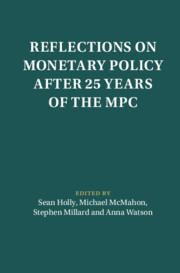Book contents
- Reflections on Monetary Policy after 25 Years of the MPC
- Macroeconomic Policy Making
- Reflections on Monetary Policy after 25 Years of the MPC
- Copyright page
- Contents
- Figures
- Tables
- Contributors
- I Overview
- II Communication
- III Targets and Instruments
- 6 The MPC Remit at 25: Growing Pains?
- 7 Raising the Inflation Target
- 8 What Have We Learnt about Unconventional Monetary Policy Tools? Lessons from the Global Pandemic
- 9 Finding New Objectives, Seeking New Instruments
- 10 Government Debt Management and Monetary Policy Before and After the MPC
- IV MPC Process
- V Lessons for Central Bank Independence
- Annex: Details on the methodology for the classification of level of disagreement
- Index
- References
8 - What Have We Learnt about Unconventional Monetary Policy Tools? Lessons from the Global Pandemic
from III - Targets and Instruments
Published online by Cambridge University Press: 14 November 2024
- Reflections on Monetary Policy after 25 Years of the MPC
- Macroeconomic Policy Making
- Reflections on Monetary Policy after 25 Years of the MPC
- Copyright page
- Contents
- Figures
- Tables
- Contributors
- I Overview
- II Communication
- III Targets and Instruments
- 6 The MPC Remit at 25: Growing Pains?
- 7 Raising the Inflation Target
- 8 What Have We Learnt about Unconventional Monetary Policy Tools? Lessons from the Global Pandemic
- 9 Finding New Objectives, Seeking New Instruments
- 10 Government Debt Management and Monetary Policy Before and After the MPC
- IV MPC Process
- V Lessons for Central Bank Independence
- Annex: Details on the methodology for the classification of level of disagreement
- Index
- References
Summary
With the start of the pandemic in 2020, central banks re-deployed unconventional policy tools used for the Global Financial Crisis but also added new and even less conventional ones. The steps they took followed a textbook description of a risk management approach to monetary policy when operating close to the effective lower bound on interest rates.[1] This involved loosening policy aggressively and working with many different instruments simultaneously to maximise policy impact. Judging from the aftermath, they were successful. They steered the economy through a crisis and avoided a depression. One could argue that the episode has shown that monetary policy can be effective also in a low interest rate environment if central banks are willing and able to deploy multiple measures with scale and speed. This suggests that central banks are well equipped for the future, irrespective of the path of interest rates.
Keywords
- Type
- Chapter
- Information
- Reflections on Monetary Policy after 25 Years of the MPC , pp. 100 - 106Publisher: Cambridge University PressPrint publication year: 2024

